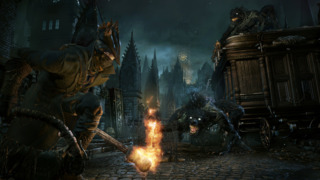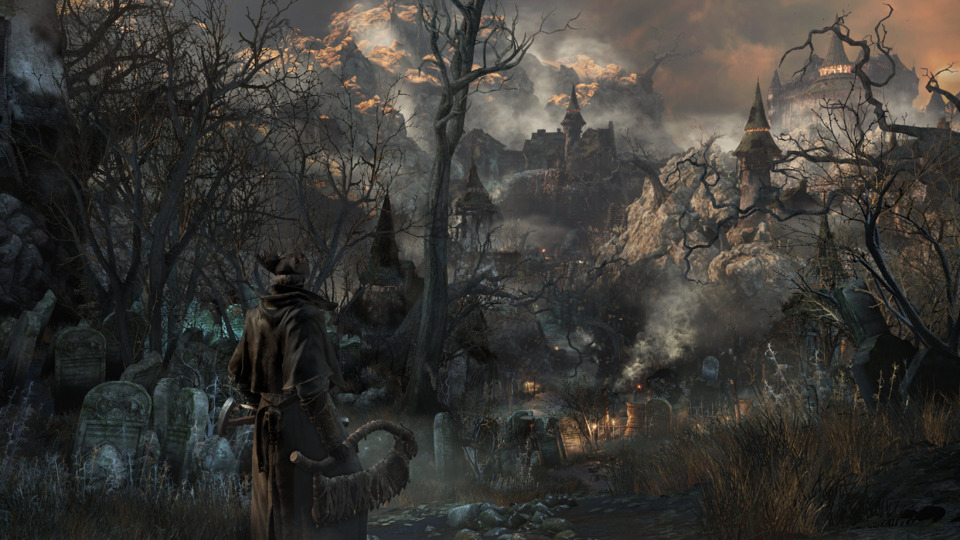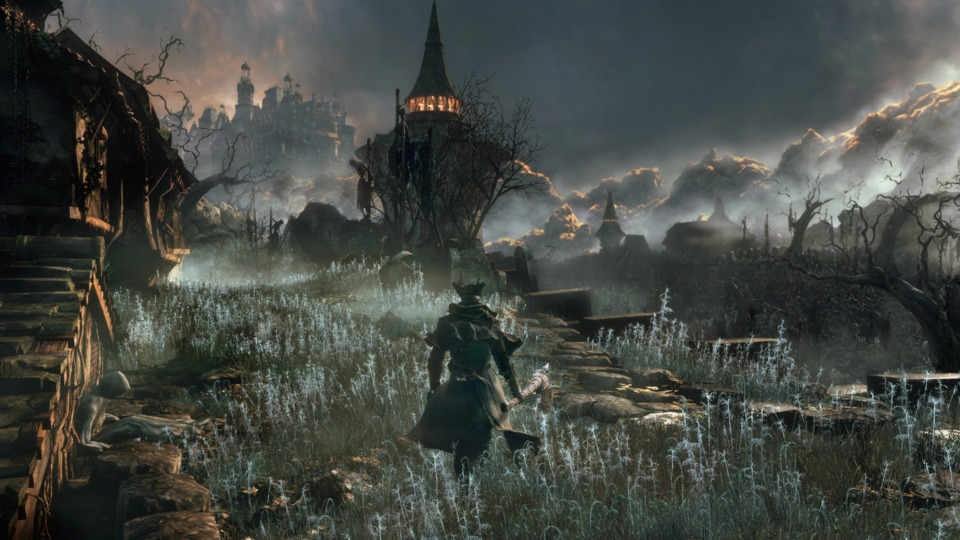
Believe it or not, there was a time when your imagination was, without doubt, the best rendering engine on the planet. My fondest memories growing up involved me describing a dungeon's most insidious contents and denizens to my friends. We’d imagine, talk, roll dice, and slay monsters from late night until early morning. In those days, video games were not much competition. Two white dots knocking a third white dot around a black screen couldn’t ever compare to the way I’d describe some particularly harrowing trap (I ran the game, I always ran them! But that’s another article), or a friend’s breathless description of his combat prowess, honoring with word and deed the 20 he just rolled.
But Moore’s law cared little about our budding imaginations. Soon we were splitting dungeon time with the Apple IIe, then Nintendo, then Genesis. Every few years the visual and audio fidelity would intrude upon our role-playing game sessions and claim another soul. Video games were easier, and they could take your breath away in a moment. They’d capture your attention and not release it for hours. Many players just found other things to do.
I didn’t. More accurately, because I like to overdo things, I’d play video games and run RPG sessions. I know a lot of people see a split between sitting at the computer and sitting with your friends but over the decades I’ve grown to see pen & paper RPGs and video games as complementary to each other. Video games are so enthralling and well-designed these days, but they do have limits. Tabletop games, I’ve found, have less immediate punch but incredible breadth; they are, for as far as the mind conceives, limitless. That divide, where video games expose their constraints and when tabletop RPGs start to pick up steam, is what I call “the Gap.”
The Gap
One of the more recent and vivid encounters I had with the Gap is playing Bloodborne. You knock on doors in the game and haunted, scarred inhabitants speak to you. Most assail you from the other side of the door with hostile, defiant attitudes. A few seek help or seek to help, but after a while I find myself wanting to know what was on the other side of these doors.
This is where the Gap lives, on the other side of doors you cannot open; reality that you can see but not touch. The Gap is the invisible walls that bound the existence and actions of your character. In Bloodborne, it is this macabre, corrupted Gothic world where all I can do is kill denizens or give simple “either/or” answers.
This is not a criticism of the game or video games in general. Bloodborne captivates me. The fidelity of modern video games comes at a price, and we must recognize that even as we enjoy those constraints. It takes many people many hours and many dollars to deliver these kinds of worlds to players. These resources are finite, and eventually game design teams are forced to stop adding features and deliver a product. The Gap is an inevitability of the current state of video game design.

Acknowledging that doesn’t prevent me from wanting to know what’s on the other side of that door. I want answers, the kind that would make me the worst sort of hunter, splintering the wood that separates me from one of the villagers of Yharnam with my axe, demanding a retraction or at least, you know, a seat, so I can catch my breath for a moment and ask them some questions. What were their lives before the Hunt, this veil of madness and monstrosity that forced them inside? Going further, what was Yharnam itself like in this mythical before-time? What were the politics in the Church as everything spiralled out of control?
Bloodborne hints at this immense, Machiavellian world driven mad by blood and religion. I get these hints from a game that I’m already excited about, and the questions make me more enthused. With my curiosity fully engaged, I want to ask and then answer these questions. The hallmark of great world building is that it inspires you to want to step inside, but that is difficult in a video game. You only have so many tools and so many options.
This is where pen and paper RPGs truly shine. They lack the immediacy and splendor of a digital game, but the fidelity comes solely with the cost of your attention. When a computer is the rendering engine, multiple people must harness that power at cost. When your mind is the rendering engine, you can generate endless episodes for free. When you play at a table (or over a voice conference) your conversations create worlds and events that need no pre-written scripts or event triggers to unfold. A few people in a shared space can win wars, re-shape dimensions, or save the world in a few hours of conversation and rolling dice.
When you want to go deeper, when you want to bridge the Gap, tabletop RPGs provide you a method of doing so.

Bridging the Gap
If you’ve never played a pen and paper role-playing game before, some of what I’m describing might seem confusing. There are many ways to define and describe RPGs. One of my favorite definitions is simplicity itself:
“It’s a game you play with friends in a social setting. Gather two to three friends and get comfy. This should take about 15-20 minutes.”
There’s more to it (there is always more!) but really you are getting together with friends, imagining and describing events and actions to each other, and finding ways to resolve events.
It’s storytelling with friends. It is a vehicle for the imagination that your group gets to drive. There are many systems that you can use to help resolve conflicts and events, but it’s best to think of each of these as a toolkit for telling stories in particular styles. It’s not about finding the “best” tool, it’s about finding the one that works for you and your friends. That said, I also have a few suggestions:
Fate Accelerated is a free, lightweight toolkit that lets you mockup elements from source material very very quickly.
Storium is an online platform for telling fiction that redefines play by post style RPGs. I ran a story based on the world of Diablo III for a while that was really fun.
PrimeTime Adventures is a great system for letting you make “seasons” and serieses out of your inspirational source material.
Again, there are many awesome RPGs out there; pick anything, just pick something.

It all starts with wanting to scratch that itch to interact differently with the world. It’s important that you don’t try too hard to interact with the world in the exact same way as the source video game, because video games are good at things that tabletop games are bad at. Looking to simulate high speed combat on pen & paper can really disappoint, as all the rules are handled by a computer in a split second and by humans in several minutes. It’s not that you can’t have combat in pen & paper, but you must understand that it serves a very different purpose than in a video game.
You’ve got a system, you’ve got some friends, you’ve got a video game world that you want to explore. The first thing you want to do is brainstorm a list of the elements of the game that you want to see. Any character cameos? What locales do you want to visit? It’s critical that (assuming everyone playing with you has played the video game) everyone gets a chance to say what it is that they want to see in the game, even if they aren’t the main facilitator for the tabletop game. You want everyone to be invested and have a chance to explore things they are interested in. This is also a time to cut those parts of the world you find unappealing. Were some of the monsters a bit silly? Maybe you don’t want to be totally covered in blood all the time? Leave those parts out.
Once you see what elements your group wants, you can then determine how the story is going start. Then comes the fun part of seeing who might facilitate, or GameMaster (GM) the sessions. I personally like to do light games or run GM-less games (everyone on equal footing) to avoid this, though I do really enjoy GMing. Organizing and running a game for your friends is rewarding and fun, but many people don’t like to do it and it is a lot of extra work.
And then it’s time to play and tell stories! You’ll make characters and start imagining yourself in this world that you once only played with a controller.

When I was younger I had a lot of time to invest in playing. We’d play for many hours and had sessions that went on for years. If you are young and have time, invest it. I don’t regret a second I spent on this hobby in my youth. If you are older with a lot of responsibilities and not a ton of time (which describes me now), don’t plan for a multi-year epic (if you are this busy and run a multi-year epic regularly, I salute you and your group!) Try to run a scenario that takes anywhere from 1-3 sessions. You can always come back later and do another story with similar characters, but being too ambitious up front inevitably leads to loose threads and dampened energy for the activity. Keeping it short and sweet with breaks in between makes it an activity that people will want to come back to.
I compared the “rendering engines” of video games and tabletop RPGs earlier, but the truth is that they don’t compare; each renders something unique. Video games deliver immediate, breath-taking experiences and gameplay while tabletop RPGs allow for more contemplation, connection and depth. Rather than thinking of the two as in opposition, there’s a lot of fun to be had by considering them as complementary. In the end, I don’t feel Moore’s law and its unrelenting pace defeated my imagination at all. By creating new visions and worlds, the increasingly vivid world of digital entertainment gives my imagination new fuel every time I pick up a controller.
Quinn Murphy thinks about games constantly. When he's not ranting on Twitter (@qh_murphy) or his blog, he is designing material for any number of game systems or designing the next great RPG (he hopes). What he most wants is to make RPGs as accessible and diverse as possible (Imagination is for Everyone!) Listen to Quinn chat with Austin on this episode of Giant Bomb Presents.